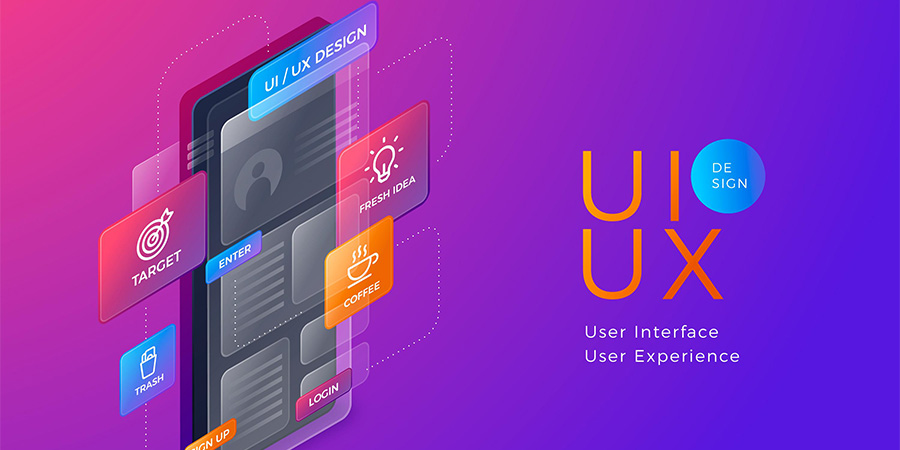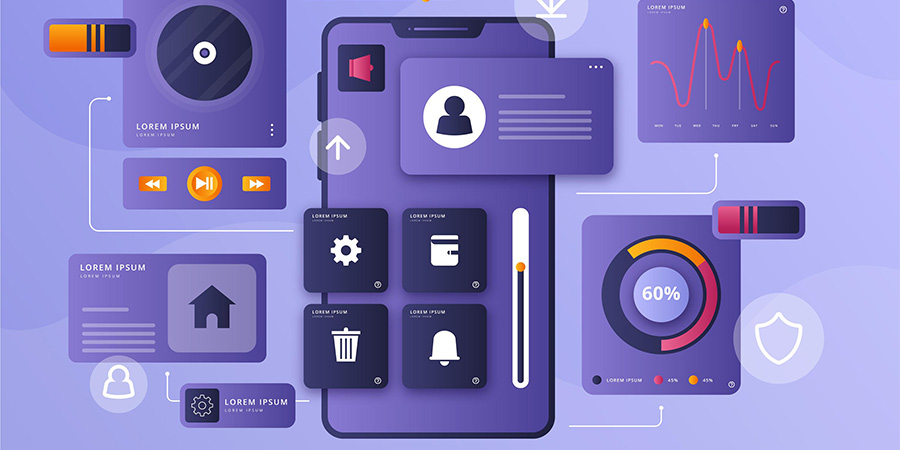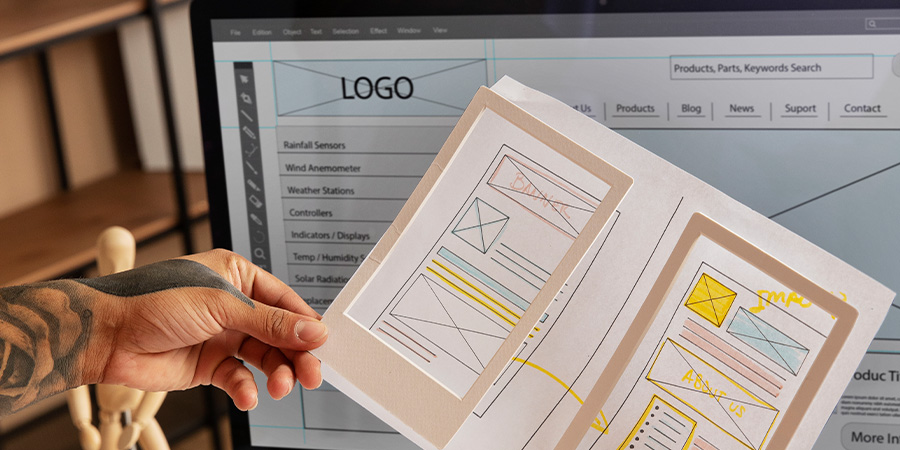Increasing Customer Satisfaction with UI/UX Design
Increasing customer satisfaction is crucial for businesses, and UI/UX design plays a key role in achieving this goal. In today’s competitive market, where choices abound, customers are quick to judge a product or service based on their initial experiences. This is where User Interface (UI) and User Experience (UX) design come into play as powerful tools for creating positive impressions and ensuring that customers keep coming back.
User-Centered Design Approach: Prioritize User Needs and Expectations
One of the fundamental principles of UI/UX design is a user-centered approach. It involves putting the needs and expectations of your users at the forefront of the design process. To achieve this, it’s crucial to conduct comprehensive user research. Understand your target audience, their preferences, pain points, and behavior patterns. This valuable insight can be integrated into your design process to create products and services that resonate with your audience.
By incorporating user feedback and involving users in the design decision-making process, you not only meet their expectations but also exceed them. This level of engagement fosters a sense of ownership among your users, making them feel heard and valued.
Responsive Design: Ensuring a Seamless Cross-Platform Experience
The modern digital landscape spans various devices, from smartphones and tablets to desktop computers. Ensuring a seamless experience across these platforms is a fundamental aspect of UI/UX design. Responsive design is the key to achieving this goal.
Responsive design allows your website or application to adapt gracefully to different screen sizes and resolutions. Users should experience the same level of functionality, convenience, and aesthetics, whether they’re accessing your product on a tiny smartphone screen or a large desktop monitor. This versatility not only increases satisfaction but also expands your reach to a broader audience.
Speed and Performance Optimization: Speeding Up User Interactions
In today’s fast-paced world, users expect near-instantaneous responses from digital platforms. Slow-loading pages and laggy interactions can quickly drive users away. Therefore, speed and performance optimization are critical components of UI/UX design.
Fast-loading pages and smooth interactions enhance customer satisfaction by reducing frustration and keeping users engaged. Techniques like image optimization, content caching, and efficient coding practices can significantly improve the speed and responsiveness of your website or application. A snappy user experience can leave a lasting positive impression.
User-Friendly Navigation: Simplifying the Path to Information
Navigating your website or app should be intuitive and effortless for users. A user-friendly navigation structure is essential for this. Menus, search functionality, and links should be logically organized and easy to understand.
Complex navigation structures can frustrate users and lead to high bounce rates. Therefore, maintain a simple, consistent, and understandable navigation system. Make it easy for users to find what they’re looking for, whether it’s information, products, or services. A well-thought-out navigation structure not only enhances satisfaction but also encourages exploration and engagement.
A/B Testing and Feedback: Continuously Improving User Experiences
The pursuit of enhanced customer satisfaction is an ongoing journey. To ensure your UI/UX design remains effective, use A/B testing and gather user feedback regularly. A/B testing involves presenting two or more versions of a design to different user groups and measuring their preferences and interactions.
User feedback, on the other hand, provides valuable insights into real user experiences and pain points. Both A/B testing and feedback collection help you make data-driven decisions and identify areas for improvement. Taking user feedback seriously and making iterative improvements is essential for continuously enhancing customer satisfaction and staying ahead of the competition.
In conclusion, a well-executed UI/UX design strategy is not only about creating visually appealing interfaces but also about crafting meaningful and delightful user experiences. By prioritizing the user, embracing responsive design, optimizing performance, ensuring user-friendly navigation, and actively seeking feedback, you can significantly enhance customer satisfaction, build customer loyalty, and drive business success. Remember, satisfied users are more likely to become loyal customers and brand advocates, which ultimately leads to increased revenue and growth.

The Impact of UI/UX Design on Brand Loyalty and Competitive Advantage
When it comes to building brand loyalty and gaining a competitive advantage, effective UI/UX design acts as a bridge between your brand and your customers. Your UI/UX should be more than just visually appealing; it should embody your brand identity and underscore your core values. Every element, from colors and fonts to graphics and overall aesthetics, should harmonize with your brand essence.
Consistency across your design and branding creates a sense of familiarity and trust among users. When users encounter a design that seamlessly aligns with your brand’s identity, it reinforces their perception of your brand’s authenticity and reliability. This, in turn, strengthens the emotional connection between your brand and its audience, a key driver of brand loyalty.
Creating a Unique User Experience: Setting Yourself Apart
In a crowded marketplace, where competitors often offer similar products or services, standing out is essential. Effective UI/UX design enables you to craft a unique user experience that differentiates your brand from the competition. This distinctiveness not only captures the attention of potential customers but also fosters brand loyalty among existing ones.
Unique user experiences can take various forms. It might be an innovative interface, a memorable interactive feature, or a personalized journey that anticipates and fulfills user needs. These distinctive elements contribute to a positive and memorable user experience, making your brand more memorable and enticing.
Focusing on User Needs: The Foundation of Brand Loyalty
Understanding your users is fundamental to building brand loyalty through UI/UX design. Successful design is not based solely on aesthetic choices; it’s rooted in an empathetic understanding of user needs. By putting yourself in your users’ shoes, you can provide an experience that caters to their preferences, expectations, and pain points.
User-centric design revolves around the principle of empathy. It means listening to your users, observing their behavior, and analyzing their feedback. This process helps you create designs that align with their desires and make their interactions with your brand effortless and enjoyable. When users feel that your product or service genuinely addresses their needs, they are more likely to become loyal advocates for your brand.
Listening to User Feedback: An Ongoing Improvement Cycle
Listening to user feedback is not a one-time task; it’s an ongoing commitment to improvement. Every piece of user feedback, whether positive or critical, is a valuable source of insights. Paying attention to user comments and suggestions and actively incorporating them into your design process is crucial for building brand loyalty.
User feedback is like a compass, guiding you toward better UI/UX design. It can reveal pain points that need to be addressed, highlight areas where your design excels, and provide ideas for enhancements. By taking users’ comments seriously and showing that you value their input, you not only improve your design but also foster a sense of community and belonging among your users, further strengthening brand loyalty.
Competitive Analysis and Enhancements: Staying Ahead
Gaining a competitive edge in the ever-evolving market requires vigilance and continuous improvement. Effective UI/UX design involves not only meeting the current expectations of your users but also anticipating their future needs and staying ahead of your competitors.
Regular competitive analysis is essential. Studying rival products or services, understanding their strengths and weaknesses, and learning from their successes and failures can provide valuable insights. By benchmarking your design against industry standards and emerging trends, you can identify areas for enhancement and innovation.
The pursuit of a competitive advantage through UI/UX design is a dynamic process. It involves staying agile, adapting to changing market conditions, and proactively seeking opportunities to outperform your rivals. By consistently striving to surpass user expectations and surpass competitors, you can maintain your brand’s relevance, strengthen loyalty, and secure a lasting competitive advantage.
In conclusion, the impact of UI/UX design on brand loyalty and competitive advantage is profound. It goes beyond aesthetics and usability; it’s about forging emotional connections, delivering unique experiences, and continuously improving based on user feedback and market dynamics. When effectively executed, UI/UX design becomes a powerful driver of brand loyalty and a critical element in maintaining a competitive edge in today’s fast-paced business landscape.

The Impact of UI/UX Design on Conversion Rates
What is the influence of UI/UX design on conversion rates, and how can you optimize it?
Steps to increase conversion rates:
Simplifying the Conversion Journey: Make the user’s conversion journey as straightforward and seamless as possible. Eliminate complexity and unnecessary steps.
Compelling Call-to-Actions (CTAs): Ensure that CTAs are clear, attention-grabbing, and easily visible. The color and placement of CTA buttons can impact conversion rates.
A/B Testing and Data Comparisons: Determine which design variations perform better through A/B testing. Data-driven insights can help you make informed decisions to increase conversion rates.
Feedback and Monitoring: Monitor user conversion processes and gather feedback. Use this data to understand why users aren’t converting and make necessary improvements.
Optimizing Mobile Conversions: Consider mobile traffic. Provide a mobile-friendly design to enhance conversions on mobile devices.

The Impact of UI/UX Design on SEO and Improvements
How does UI/UX design affect SEO, and how can you make improvements in this area?
Methods for SEO-focused UI/UX design:
Speed and SEO: Page speed is a factor considered by search engines. Fast-loading pages improve user experience and positively impact SEO.
Mobile Compatibility: Offering a good experience on mobile devices is crucial for mobile SEO. Ensure compliance with Google’s mobile compatibility standards.
Search-Friendly URLs: Use clean, understandable, and descriptive URLs to assist search engines.
Content and User Experience: Offer valuable content for users and make it easy to find. User experience encourages users to spend more time on your site and convert.
Search Analysis and Keyword Research: Conduct keyword research and analyze how users find your site. This data can guide your design and content strategy.

Integrating UI/UX Design with Data Analytics
How can data analytics and UI/UX design be integrated, making user experiences more data-driven?
Methods to combine data analytics and UI/UX design:
User Behavior Analysis: Track user behavior on your website or application. Use data to optimize your design based on which features are most used and which pages are most visited.
A/B Testing and Data Comparisons: Use A/B testing to compare different design variations and identify which design performs better. Make improvements based on data.
Personalized Experiences: Use data analytics to create personalized experiences based on user interests and behaviors. For example, offer recommendations tailored to individual users.
Conversion Tracking: Monitor conversion rates and track user journeys. Understand why users do or do not convert, and make design adjustments accordingly.
Data Visualization: Present data in user-friendly graphics and visuals to help users understand it better. This can encourage users to spend more time on your site.

The Importance of Using Dark Mode in UI/UX Design: A Guide to Enhancing User Experience
Dark mode has become an indispensable feature in contemporary web and mobile app design. In this article, discover how the use of dark mode can enhance the user experience and potentially contribute to SEO benefits.
Dark mode has emerged as a fundamental feature of modern UI/UX design, offering both aesthetic and functional advantages that cater to user preferences and needs. Additionally, it may offer potential benefits from an SEO perspective. In this article, we will explore the significance of using dark mode in UI/UX design and how to effectively implement it.
What Is Dark Mode?
Dark mode is a display mode that presents the background of an application or website in dark or black colors while using light-colored text. This mode is particularly beneficial for reducing eye strain during nighttime or low-light conditions. Moreover, it may result in energy savings for certain screen technologies, extending the battery life of mobile devices.
Dark Mode and User Experience
Reduces Eye Strain: Dark mode diminishes eye strain during prolonged screen usage, allowing users to engage with your application or website for longer durations.
Enhances Contrast: Dark backgrounds with light text make content more distinct, improving readability and enabling users to consume content more comfortably.
Aesthetic and Modern Appeal: Dark mode offers an aesthetic and contemporary appearance that appeals to many users, making your application or website visually appealing.
Energy Efficiency: Dark mode can save energy on screens using OLED and AMOLED technologies, extending the battery life of mobile devices, which is advantageous for users.
Dark Mode and SEO
The use of dark mode may provide potential SEO advantages:
Enhanced User Experience: User experience is a significant component of SEO. When users have a better experience with dark mode, they may visit your website or application more frequently, potentially increasing visitor traffic.
Extended Time on Site: Users who find dark mode comfortable and conducive to prolonged use may spend more time on your site, contributing to improved SEO performance.
Search Engine Rankings: As dark mode enhances the user experience, search engines may view it as a positive factor, potentially contributing to improved search engine rankings.
Implementing Dark Mode
The implementation of dark mode may vary depending on your design and user requirements. Here are some tips for successfully incorporating dark mode:
Allow User Choice: Provide users with the option to enable or disable dark mode based on their preferences.
Mindful Color Selection: Ensure a good contrast between dark and light colors.
Maintain Visual Consistency: Preserve page layout and content consistency in dark mode.
Testing and Feedback: Continuously improve dark mode through user testing and feedback.
In conclusion, dark mode usage can enhance the user experience and potentially offer SEO benefits. By considering user preferences and needs, you can seamlessly integrate dark mode into your design, leading to increased user satisfaction and potential SEO performance improvements.
Join the best digital agency, made by iocaste.
You can follow us more closely and stay updated by connecting with us on social media. For the latest content, events, and more, visit our Facebook and Instagram pages. Start following us by clicking on the links below!
Facebook: facebook/iocaste.co
Instagram: instagram.com/iocaste.co
Join us to experience an interactive journey and enjoy staying informed!
Table of Contents
Toggle

